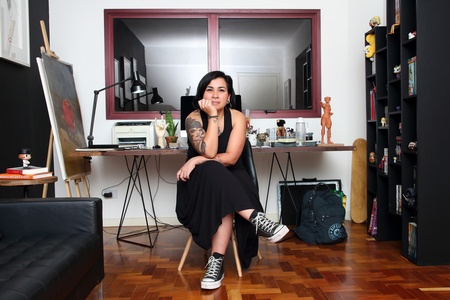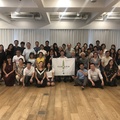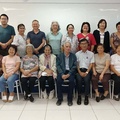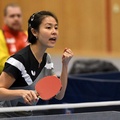From about 10 years ago, tattoo has been gaining another status in Brazil. Previously, the common peception was that only gangsters had them. Today, people of various professions and backgrounds carry on the body what is increasingly accepted as a “work of art”.
“I won't deny that some people still look in a weird way. Society is evolving and understanding that it is an artistic matter. Talking with clients, I learn that some professions still do not view the tattoo positively. For example, doctors and nurses, often because of patients. The tabooish view, of prejudice, is more restricted to older people. If my grandmother were alive, she would be shocked and think it was not a very cool thing to do. My parents states they wouldn't do it themselves, but they say it is cool,” says Sheila Oi, 37, Sansei from her father’s side and of Spanish and Italian ancestry from her mother’s.
Sheila has been working as a tattoo artist for seven years in Sao Paulo. Her work system is based on unique tattoos, meaning it involves everything, starting from art design to tattoo execution itself. Thus, she does not perform creations by other artists, nor does she repeat an art on more than one client. “I have the privilege of meeting each day a different person, a different story, because each one chooses the tattoo for a reason. Tribute someone special, mark a moment of life. This is very important for me in order to design the whole project,” says Sheila.
Diversity
The increasing popularity of tattooing is easily noticed. Just a quick walk around the city is enough to see a wide variety of motifs, revealing the multiple interests of those who want to be tattooed.
“My audience is very diverse. I've served athletes, teachers, baristas, designers, chefs, programmers, lawyers, and even doctors. Most are usually descendants [of Japanese] and lovers of Asian culture. I also serve the LGBT public frequently,” says Ayuh Ieiri, Sansei.
Ayuh also works as a computer, arts, and language teacher. “I've always loved the art [of tattooing], but I just thought about being a tattoo artist in recent years, and the opportunity came. I started studying it in late 2017, but my debut happened in April 2018.”
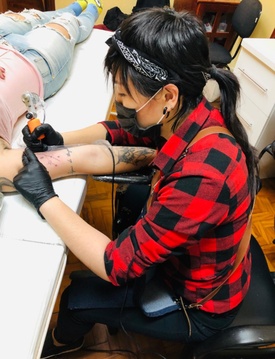
Her Instagram account features a solid work of illustrations, which gradually began to share space with the tattoo jobs. “While illustrating is very similar to tattooing, it's also different. The main difference is that in an illustration, depending on the technique used, it is possible to undo an error or even modify the initial art concept. In tattooing, as it is a 'living' canvas (the skin), one should avoid making any mistakes as much as possible. What's more, the [tattoo] machine has its characteristic weight and vibration. Thus, focus, concentration, and especially training are very important for the technique to be very well performed. Courses and workshops are always important for learning. This year I attended a workshop about tattooed skin care by a dermatologist. ” In Sao Paulo, a business license for tattoo studios and a certificate from the Sanitary Surveillance Agency are required. For the time being, the professional who will do the tattoo has no legal requirements.
“In this state, only those over 18 can be tattooed,” explains Sheila. “So, from 18, my oldest client was 75 when I did his tattoo. Today, after almost seven years of work, I have a consolidated style, and people look for my name. Most clients are in the range of 25 to 35, with a large percentage of male audience. These are people who like everything from geek to Asian writing, kanji, dragons, lotus and buddhas. A few years ago, tattooing a geek illustration wasn't so cool. A Pokémon, for example. Today, no problem, because the tattoo tells a little about who you are.”
In Japan, there is a strong association of tattooing with the mafia. In Brazil, would there be any reflection of strangeness on the part of the Nikkei? Sheila makes a remark: “I have noticed in Liberdade [the Asian district of Sao Paulo] that there are descendants of Japanese and Chinese who look disapprovingly at Brazilians without Asian ancestry with an Asian motif tattoo.”
“Some characteristic drawings of Japanese culture, such as the dragon and the carp, are images that have become popular in the West in an absurd way. I think we have to respect the differences of culture. If one wants to make a dragon, I don't think it is so hard to research its meaning. Not that it's a must. I like to research because it enriches the work. There is a graphic matter that we have to respect. Regardless of the culture and the changes that come with time, it is important to research so as not to lose its essence. Preserving tradition, even if a new interpretation is done, is a feature of Japanese culture as well,” continues Sheila.
Only kawaii?
For two Nikkei tattoo artists, would you expect them to work only with Asian themes or kawaii designs? It's not like this.
“It's not my target. I've been doing a lot of work involving the geek and otaku world because people identify them to my style. However, there was never this association just because of being a descendant or due to my knowledge of the culture. Some people, when they know that I have a degree in Fine Arts and have researched manga (a style I have been drawing for many years) for my graduation paper and Masters, feel more comfortable looking for my work to be sure of the outcome,” Sheila explains.
“This doesn't happen to me much, maybe because I have a slightly more alternative style and absorb different cultures from my origins,” says Ayuh. “I'm a citizen of the world and I like to show that in my art too.”
Ayuh has traveled to many countries in Europe and South America. “I remember one time I was in France in 2018, when I shared a room with a girl from Mongolia and another from Taiwan, who were surprised when I, with my face featuring almost the same racial traits as theirs, said I was Brazilian. They were amazed when I showed pictures of my descendant friends, who, like me, were Brazilian. Few people know that Brazil is the second country with the largest population with Japanese blood outside Japan. Another time, it happened when a store clerk, also in a European country, could not stand the curiosity and asked me where I was from, even having the traits of Asians, I didn't seem to be from any Asian country because of my clothes and even my way of walking. She thought I was an Asian American. I have fun with these situations.”
Sheila plans to work as a guest at a tattoo studio abroad. It's a kind of internship where a foreign tattoo artist works temporarily as a guest in a studio. “It is super important to travel, even within Brazil, and seeing another professional tattooing always enriches the work.”
“The goal is going to the US, which is the birthplace of tattooing. I would like to go to Europe too. It is a different style with a different pigmentation. I would love to go to Japan to learn tebori. In New Zealand, there is the Maori style, which is a very rudimentary tattoo style. There are so many cool styles that it would be really nice to see closely, to experience, not just by watching a video on the internet”, says Sheila.
Nikkei identity
“I had intense contact with Japanese culture because I lived with my obachan and ojichan. My obachan never stopped speaking nihongo at home, even though we didn't understand. The interest in culture was mine, as they never told me to look for it. I identify myself a lot with Japanese culture and keep studying it. It adds a lot at work and in life too. I carry my grandmother's teachings to this day. To always be very honest and take care of all the details even in the simplest things. My obachan was a seamstress, so she did everything very carefully, no matter how long it took. She said that everything had to be very well thought out with care and responsibility, because she was dedicating her work and time to someone, so it wasn't something to do carelessly, do it well,” says Sheila.
“I believe that Nikkei identity is a set of many factors that are not only limited to living with other members, but also the preservation of our ancestors' values and the culture itself. Discipline, respect, effort, and gratitude. This in both personal and professional life. The positive side is that some people who don’t share my ethnicity get closer because they admire, respect, and identify with the culture, and so there is an exchange of information and experiences. The downside is that, unfortunately, there are people who stereotype us because of our appearance, bringing with them all labels that are often not true at all. These labels have racist, xenophobic, sexist, etc. connotations. This is a very sensitive subject, hotly debated in the Asian community today and deserves attention. Not only do I speak of Asian ethnicity, but all those who deserve to be heard and respected,” states Ayuh.
For further information:
- Sheila Oi (in Portuguese)
- Ayuh Ieiri
© 2019 Henrique Minatogawa




